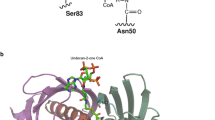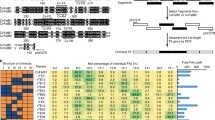Abstract
Cytosolic acyl-CoA-binding proteins (ACBPs) are small proteins (ca. 10 kDa) that bind long-chain acyl-CoAs and are involved in the storage and intracellular transport of acyl-CoAs. Previously, we have characterized an Arabidopsis thaliana cDNA encoding a novel membrane-associated ACBP, designated ACBP1, demonstrating the existence of a new form of ACBP in plants (M.-L. Chye, Plant Mol. Biol. 38 (1998) 827–838). ACBP1 likely participates in intermembrane lipid transport from the ER to the plasma membrane, where it could maintain a membrane-associated acyl pool (Chye et al., Plant J. 18 (1999) 205–214). Here we report the isolation of cDNAs encoding ACBP2 (M r 38 479) that shows conservation in the acyl-CoA-binding domain to previously reported ACBPs, and contains ankyrin repeats at its carboxy terminus. These repeats, which likely mediate protein-protein interactions, could constitute a potential docking site in ACBP2 for an enzyme that uses acyl-CoAs as substrate. In vitro binding assays on recombinant (His)6-ACBP2 expressed in Escherichia coli show that it binds 14[C]palmitoyl-CoA preferentially to 14[C]oleoyl-CoA. Analysis of the acyl-CoA-binding domain in ACBP2 was carried out by in vitro mutagenesis. Mutant forms of recombinant (His)6-ACBP2 with single amino acid substitutions at conserved residues within the acyl-CoA-binding domain were less effective in binding 14[C]palmitoyl-CoA. Northern blot analysis showed that the 1.6 kb ACBP2 mRNA, like that of ACBP1, is expressed in all plant organs. Analysis of the ACBP2 promoter revealed that, like the ACBP1 promoter, it lacks a TATA box suggesting the possibility of a housekeeping function for ACBP2 in plant lipid metabolism.
Similar content being viewed by others
References
Albert, S., Despres, B., Guilleminot, J., Bechtold, N., Pelletier, G., Delseny, M. and Devic, M. 1999. The EMB 506 gene encodes a novel ankyrin repeat containing protein that is essential for the normal development of Arabidopsis embryos. Plant J. 17: 169–179.
Alho, H., Costa, E., Ferrero, P., Fujimoto, M., Cosenza-Murphy, D. and Guidotti, A. 1985. Diazepam-binding inhibitor: a neuropeptide located in selected neuronal populations of rat brain. Science 229: 179–182.
Ausubel, F.M., Brent, R., Kingston, R.E., Moore, D.D. Seidman, J.G., Smith, J.A. and Struhl, K. 1995. Current Protocols in Molecular Biology. Greene Publishing Associates/John Wiley, New York.
Bork, P. 1993. Hundreds of ankyrin-like repeats in functionally diverse proteins: mobile modules that cross phyla horizontally? Proteins Struct. Funct. Genet. 17: 363–374.
Bradford, M.M. 1976. A rapid and sensitive method for the quantifi-cation of microgram quantities of protein utilizing the principle of protein-dye binding. Anal. Biochem. 72: 248–254.
Browse, J. and Somerville, C.R. 1991. Glycerolipid synthesis. Annu. Rev. Plant Physiol. Plant Mol. Biol. 42: 467–506.
Cao, H., Glazebrook, J., Clarke, J.D., Volko, S. and Dong, X. 1997. The Arabidopsis NPR1 gene that controls systemic acquired resistance encodes a novel protein containing ankyrin repeats. Cell 88: 57–63.
Chye, M.-L. 1998. Arabidopsis cDNA encoding a membraneassociated protein with an acyl-CoA binding domain. Plant Mol. Biol. 38: 827–838.
Chye, M.-L., Huang, B.-Q. and Zee, S.Y. 1999. Isolation of a gene encoding Arabidopsis membrane-associated acyl-CoA binding protein and immunolocalization of its gene product. Plant J. 18: 205–214.
Engeseth, N.J., Pacovsky, R.S., Newman, T. and Ohlrogge, J.B. 1996. Characterization of an acyl-CoA-binding protein from Arabidopsis thaliana. Arch. Biochem. Biophys. 331: 55–62.
Faergeman, N.J., Sigurskjold, B.W., Kragelund, B.B., Andersen, K.V. and Knudsen, J. 1996. Thermodynamics of ligand binding to acyl-coenzyme A binding protein studied by titration calorimetry. Biochemistry 35: 14118–14126.
Faergeman, N.J. and Knudsen, J. 1997. Role of long-chain fatty acyl-CoAs esters in the regulation of metabolism and cell signalling. Biochem. J. 323: 1–12.
Gray, P.W., Glaister, D., Seeburg, P.H., Guidotti, A. and Costa, E. 1986. Cloning and expression of cDNA for human diazepam binding inhibitor, a natural ligand of an allosteric regulatory site of theγ-aminobutyric acid type A receptor. Proc. Natl. Acad. Sci. USA 83: 7547–7551.
Hills, M.J., Dann, R., Lydiate, D. and Sharpe, A. 1994. Molecular cloning of a cDNA from Brassica napus L. for a homologue of acyl-CoA binding protein. Plant Mol. Biol. 25: 917–920.
Joshi, C.P. 1987. An inspection of the domain between putative TATA box and translation start site in 79 plant genes. Nucl. Acids Res. 15: 6643–6653.
Klein, P., Kanehisa, M. and De Lisi, C. 1985. The detection and classification of membrane-spanning proteins. Biochim. Biophys. Acta 815: 468–476.
Knudsen, J. 1991. Acyl-CoA binding and transport, an alternative function for diazepam binding inhibitor, which is identical with acyl-CoA binding protein. Neuropharmacology 30: 1405–1410.
Kolmer, M., Alho, H., Costa, E. and Pani, L. 1993. Cloning and tissue-specific functional characterization of the promoter of the rat diazepam binding protein inhibitor, a peptide with multiple biological actions. Proc. Natl. Acad. Sci. USA 90: 8439–8443.
Kolmer, M., Roos, C., Tirronen, M., Myohanen, S. and Alho, H. 1994. Tissue-specific expression of the diazepam-binding inhibitor in Drosophila melanogaster: cloning, structure and localization of the gene. Mol. Cell. Biol. 14: 6983–6995.
Kragelund, B.B., Andersen, K.V., Madsen, J.C., Knudsen, J. and Poulsen, F.M. 1993. Three-dimensional structure of the complex between acyl-coenzyme A binding protein and palmitoylcoenzyme A. J. Mol. Biol. 230: 1260–1277.
Laemmli, U.K. 1970. Cleavage of structural proteins during the assembly of the head of bacteriophage T4. Nature 227: 680–685.
Lemieux, B., Koornneef, M. and Feldmann, K.A. 1994. Epicuticular wax and eceriferum mutants. In: E.M. Meyerowitz and C.R. Somerville (Eds.) Arabidopsis, Cold Spring Harbor Laboratory Press, Plainview, NY, pp. 1031–1047.
Lihrmann, I., Plaquevent, J.-C, Tostivint, H., Raijmakers, R., Tonon, M.-C., Conlon, J.-M. and Vaudry, H. 1994. Frog diazepambinding inhibitor: peptide sequence, cDNA cloning, and expression in the brain. Proc. Natl. Acad. Sci. USA 91: 6899–6903.
Lutcke, H.A., Chow, K.C., Mickel, F.S., Moss, K.A., Kern, H.F. and Scheele, G.A. 1987. Selection of AUG initiation codons differs in plants and animals. EMBO J. 6: 43–48.
Mandrup, S., Hummel, R., Ravn, S., Jensen, G., Andreasen, P.H., Gregersen, N., Knudsen, J. and Kristiansen, K. 1992. Acyl-CoA binding protein/diazepam binding inhibitor gene and pseudogenes. A typical housekeeping gene family. J. Mol. Biol. 228: 1011–1022.
Marquardt, H., Todaro, G.J. and Shoyab, M. 1986. Complete amino acid sequences of bovine and human endozepines. Homology with rat diazepam binding inhibitor. J. Biol. Chem. 261: 9727–9731.
Michaely, P. and Bennett, V., 1992. The ANK repeat: a ubiquitous motif involved in macromolecular recognition. Trends Cell Biol. 2: 127–129.
Mikkelsen, J., Hojrup, P., Nielsen, P.F., Roepstorff, P. and Knudsen, J. 1987. Amino acid sequence of acyl-CoA-binding sequence from cow liver. Biochem. J. 245: 857–861.
Mikkelsen, J. and Knudsen, J. 1987. Acyl-CoA binding protein from cow. Biochem. J. 248: 709–714.
Mocchetti, E., Einstein, R. and Brosius, J. 1986. Putative diazepam binding inhibitor peptide: cDNA clones from rat. Proc. Natl. Acad. Sci. USA 83: 7221–7225.
Moreau, P., Bessoule, J.J., Mongrand, S., Testet, E., Vincent, P. and Cassagne, C. 1998. Lipid trafficking in plant cells. Prog. Lipid Res. 37: 271–391.
Nagy F., Kay S.A., Chua N-H. 1988. Analysis of gene expression in transgenic plants. In: S.V. Gelvin and R.A. Schilperoort (Eds.) Plant Molecular Biology Manual, Kluwer Academic Publishers, Dordrecht, Netherlands, pp. B4: 1–29.
Ohlrogge, J.B., Kuhn, D.N. and Stumpf, P.K. 1979. Subcellular localization of acyl carrier protein in leaf protoplasts of Spinacia oleracea. Proc. Natl. Acad. Sci. USA 76: 1194–1198.
Post-Beittenmiller, D. 1996. Biochemistry and molecular biology of wax production in plants. Annu. Rev. Plant Physiol. Plant Mol. Biol. 47: 405–430.
Rasmussen, J, T., Borchers, T. and Knudsen, J. 1990. Comparison of the binding affinities of acyl-CoA binding protein and fatty acid binding protein for long-chain acyl-CoA esters. Biochem. J. 265: 849–855.
Rasmussen, J.T., Faergeman, N.J., Kristiansen, K. and Knudsen, J. 1994. Acyl-CoA binding protein (ACBP) can mediate intermembrane acyl-CoA transport and donate acyl-CoA for β-oxidation and glycerolipid synthesis. Biochem. J. 299: 165–170.
Rasmussen, J.T., Rosendal, J. and Knudsen, J. 1993. Interaction of acyl-CoA binding protein (ACBP) on processes for which acyl-CoA is a substrate, product or inhibitor. Biochem. J. 292: 907–913.
Reddy, A.S., Ranganathan, B., Haisler, R.M. and Swize, M.A. 1996. A cDNA encoding acyl-CoA binding protein from cotton (accession No. U35015). (PGR96–028). Plant Physiol. 111: 348.
Rose, T.M., Schultz, E.R. and Todaro, G.J. 1992. Molecular cloning of the gene for the yeast homolog (ACB) of diazepam binding inhibitor/endozepine/acyl-CoA-binding protein. Proc. Natl. Acad. Sci. USA 89: 1287–1291.
Sambrook, J., Fritsch, E.F. and Maniatis, T. 1989. Molecular Cloning: A Laboratory Manual, 2nd ed. Cold Spring Harbor Laboratory Press, Plainview, NY.
Sanger, F., Nicklen, S. and Coulsen, A.R. 1977. DNA sequencing with chain-termination inhibitors. Proc. Natl. Acad. Sci. USA 74: 5463–5467.
Sentenac, H., Bonneaud, N., Minet, M., Lacroute, F., Salmon, J.-M., Gaymard, F. and Grignon C. 1992. Cloning and expression in yeast of a plant potassium ion transport system. Science 256: 663–665.
Swinnen, J.V., Esquenet, M., Rossels, J., Claessens, F., Rombauts, W., Heyns, W. and Verhoeven, G. 1996. A human gene encoding diazepam-binding inhibitor/acyl-CoA-binding protein: transcription and hormonal regulation in the androgen-sensitive human prostatic adenocarcinoma cell line LNCaP. DNA Cell Biol. 15: 197–208.
Webb, N.R., Rose, T.M., Malik, N., Marquardt, H., Shoyab, M., Todaro, G.J. and Lee, D.C. 1987. Bovine and human cDNA sequence encoding a putative benzodiazepine receptor ligand. DNA 6: 71–79.
Yanisch-Perron, C., Vieira, J. and Messing, J. 1985. Improved M13 phage cloning vectors and host strains: nucleotide sequences of the M13mp18 and pUC19 vectors. Gene 33: 103–119.
Zhang, H., Scheirer, D.C., Fowle, W.H. and Goodman, H.M. 1992. Expression of antisense or sense RNA of an ankyrin repeat-containing gene blocks chloroplast differentiation in Arabidopsis. Plant Cell 4: 1575–1588.
Zimmermann, S., Talke, I., Ehrhardt, T., Nast, G. and Muller-Rober, B. 1998. Characterization of SKT1, an inwardly rectifying potassium channel from potato, by heterologous expression in insect cells. Plant Physiol. 116: 879–890.
Author information
Authors and Affiliations
Rights and permissions
About this article
Cite this article
Chye, ML., Li, HY. & Yung, MH. Single amino acid substitutions at the acyl-CoA-binding domain interrupt 14[C]palmitoyl-CoA binding of ACBP2, an Arabidopsis acyl-CoA-binding protein with ankyrin repeats. Plant Mol Biol 44, 711–721 (2000). https://doi.org/10.1023/A:1026524108095
Issue Date:
DOI: https://doi.org/10.1023/A:1026524108095




